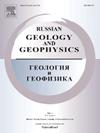从局部地震层析成像和震源机制数据看马尔科-彼得罗巴甫洛夫斯克断裂带的边界区结构
IF 1
4区 地球科学
Q3 GEOSCIENCES, MULTIDISCIPLINARY
引用次数: 0
摘要
--本研究继续分析从2018-2020年的密集局部网络数据中获得的堪察加中部带超俯冲杂岩的新地震断层结构,并致力于分析马尔科-彼得罗巴甫洛夫斯克断裂带边缘及其周围的速度结构。地震层析成像模型涉及2018年8月至2020年7月2963次局部地震的约98000次P波和S波传播时间。该模型的分辨率使追踪南堪察加半岛和东部火山带火山的补给系统到板块表面,以及识别颠覆性结构断层成为可能。为了构建压缩轴和伸展轴的方向,我们使用了国际地震中心目录中1979年至2019年期间41次М≥4.5地震的震源机制。沿着Malko Petropavlovsk断裂带,在几乎整个模型深度的速度异常的几何形状和相互排列中,可以清楚地追踪到Avacha转换断层。地震异常与震源机制压缩和伸展轴分布方向图的比较表明,沿Avacha转换断层的速度异常值变化与轴方向变化几乎180°之间存在相关性。在Srediny山脊南端Malko Petropavlovsk带的西部边界发现了深度为25-35公里的近地表低速异常。这一异常可能标志着沿着斯雷丁尼山脊的古代火山前缘和现代活跃的东部火山带的轴线交界带边界,这是克罗诺茨基古弧吸积的结果。在Sredinny山脊南端的西面,发现了另一个低速异常。该异常被追踪到约150公里的深度,具有对比鲜明的南部边界,通过地震震源机制的压缩和伸展轴方向的分布得到证实,并明显标志着西堪察加地块的南部边缘。本文章由计算机程序翻译,如有差异,请以英文原文为准。
The Boundary Areas Structure of the Malko-Petropavlovsk Fracture Zone from Local Seismic Tomography and Earthquake Foci Mechanisms Data
—This study continues analysis of the new seismic tomographic structure of the suprasubduction complex of the central zone of Kamchatka, obtained from the dense local networks data of 2018–2020, and is devoted to the analysis of the velocity structure in the Malko-Petropavlovsk fracture zone margins and around them. The seismic tomographic model involves about 98,000 P- and S-wave travel times from 2963 local earthquakes from August 2018 to July 2020. The resolution of this model makes it possible to trace the feeding systems of volcanoes of the South Kamchatka and East Volcanic Belt to the slab surface, as well as to identify subvertical structural faults. To construct the orientations of the compression and extension axes we used the foci mechanisms of 41 earthquakes with М ≥ 4.5 from the catalog of the International Seismological Center for the period 1979–2019. Along the Malko-Petropavlovsk fracture zone, the Avacha transform fault is clearly traced in the geometry and mutual arrangement of velocity anomalies almost throughout the entire depth of the model. Comparison of seismic anomalies with a map of the directions of the compression and extension axes distribution from the earthquake foci mechanisms showed the correlation between the change in the value of the velocity anomalies along the Avacha transform fault with the axes direction change by almost 180°. A near-surface low-velocity anomaly to the depths of 25–35 km was found along the western border of the Malko-Petropavlovsk zone under the southern tip of the Sredinny Ridge. This anomaly probably marks the axes junction zone boundary of the ancient volcanic front along the Sredinny Ridge and the modern active Eastern Volcanic Belt, which formed as a result of the Kronotsky paleoarc accretion. To the west from the Sredinny Ridge southern tip, another low-velocity anomaly was revealed. This anomaly was traced to a depth of ~150 km, has a contrasting southern boundary confirmed by the distribution of the compression and extension axes directions by the earthquake foci mechanisms and apparently marks the southern boundary of the West Kamchatka block.
求助全文
通过发布文献求助,成功后即可免费获取论文全文。
去求助
来源期刊

Russian Geology and Geophysics
地学-地球科学综合
CiteScore
2.00
自引率
18.20%
发文量
95
审稿时长
4-8 weeks
期刊介绍:
The journal publishes original reports of theoretical and methodological nature in the fields of geology, geophysics, and geochemistry, which contain data on composition and structure of the Earth''s crust and mantle, describes processes of formation and general regularities of commercial mineral occurrences, investigations on development and application of geological-geophysical methods for their revealing. As to works of regional nature, accelerated publication are available for original papers on a variety of problems of comparative geology taking into account specific character of Siberia, adjacent Asian countries and water areas. The journal will also publish reviews, critical articles, chronicle of the most important scientific events, and advertisements.
 求助内容:
求助内容: 应助结果提醒方式:
应助结果提醒方式:


